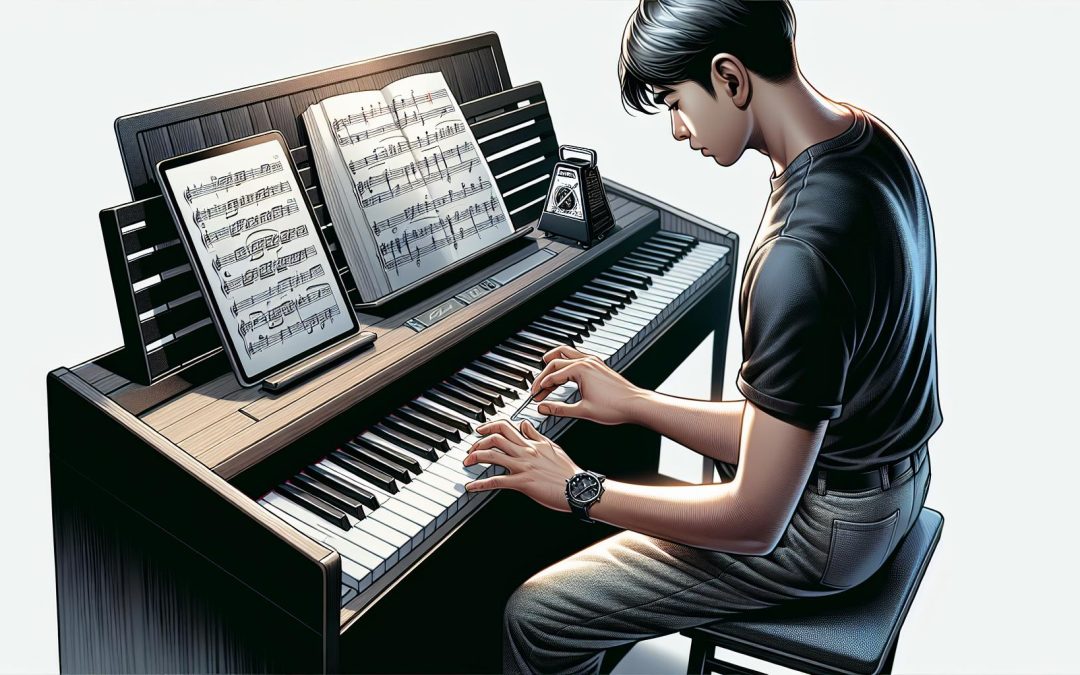Sight-reading music, especially on the keyboard, can feel like decoding a mysterious language at first. It's a skill that requires patience, practice, and a bit of know-how. For beginners, diving into this world can be both thrilling and a tad intimidating. But fear not! With the right approach, anyone can start their journey toward becoming a proficient sight-reader.
Imagine sitting at your keyboard, sheet music in front of you, and playing it effortlessly without hours of practice on that specific piece. That's the magic of sight-reading! It opens up a whole new realm of musical exploration and enjoyment. Whether you're aspiring to play classical masterpieces or just want to jam out to your favorite tunes, mastering sight-reading is a game-changer.
Understanding Sight-Reading
Sight-reading on the keyboard isn't just about hitting the right notes; it's about understanding and interpreting the musical language laid out before you. Imagine being able to open any music book and fluently read through it as if it were your favorite novel. That's the magic of sight-reading! For beginners, this might seem like a daunting task, but with patience and practice, it's incredibly rewarding.
Sight-reading involves several key skills:
- Music notation recognition: This is the ability to quickly identify notes, rhythms, and other symbols on the sheet music.
- Hand-eye coordination: Your eyes need to scan the music while your hands move accordingly without much lag.
- Musicality: Beyond just notes, understanding dynamics, articulation, and expression are crucial for bringing music to life.
Starting Your Sight-Reading Journey
The first step is familiarizing yourself with the basics of music theory. Knowing how to read music will be your foundation. Beginners should start with simple pieces, focusing on recognizing patterns such as scales, arpeggios, and chords. These patterns are common in most compositions, and identifying them will make sight-reading much easier.
Another helpful tip is to set realistic goals. You might not ace your first sight-reading attempt, and that's okay. Celebrate small victories and gradually increase the difficulty of the pieces you attempt to read.
Daily Practice is Key
Just like learning a new language, daily practice is essential for improvement. Dedicate at least 15 minutes a day to sight-reading new pieces. Start with slow, manageable compositions and resist the urge to stop and correct every mistake. The goal is to keep going, simulating a real sight-reading scenario where you don't have the luxury to go back.
Utilizing Technology
Leveraging technology can also enhance your sight-reading skills. There are numerous apps and online resources targeted at improving music reading competence. Some platforms offer interactive exercises designed to boost your note recognition speed, rhythm understanding, and overall musical comprehension.
Reading Ahead
An invaluable skill in sight-reading is learning to read ahead. This means not just focusing on the notes you're currently playing but also glancing at future measures. This skill allows for smoother transitions, better tempo maintenance, and more musical expression.
| Skill | Benefit |
|---|---|
Benefits of Sight-Reading Keyboard Music

Sight-reading keyboard music offers an array of benefits that extend beyond the realm of music itself. For beginners, the process of learning to sight-read can seem daunting, but the rewards are numerous, impacting both musical proficiency and cognitive skills.
Firstly, sight-reading enhances cognitive function. It's an activity that requires the brain to work quickly and efficiently. The reader must decode symbols (notes, rhythms, articulations) and translate them into physical actions without pause. This active engagement boosts memory, concentration, and problem-solving skills, contributing to a sharper mind.
Moreover, sight-reading builds musical independence. Musicians who can sight-read confidently are not reliant on others to decipher music for them or limited to pieces they have memorized. They can explore a wide repertoire, playing new pieces at a glance. This independence encourages exploration and a broader understanding of music genres and styles.
Another key benefit is the improvement in hand-eye coordination. Sight-reading on the keyboard demands precise coordination between what the eyes see and how the hands move. This skill is crucial not only for music but also enhances fine motor skills in everyday activities.
Sight-reading also promotes quicker learning of new pieces. A musician proficient in sight-reading can learn pieces much faster than those who learn by ear or memorization alone. This efficiency is especially beneficial for those involved in ensemble work or accompaniment, where learning new material quickly is often required.
The ability to sight-read opens up opportunities for social connections and musical collaboration. Being able to join a band, ensemble, or accompany singers without needing extensive preparation time allows for more spontaneous and enjoyable music-making experiences. It's also a skill highly regarded in the professional music world, leading to more performance opportunities.
Lastly, sight-reading can significantly increase confidence and reduce performance anxiety. The more exposure musicians have to sight-reading, the more adept they become at handling surprises or mistakes during performances. Knowing that they can manage unfamiliar pieces reduces anxiety and builds confidence in their abilities.
Essential Techniques for Beginners

Starting the journey of learning to sight-read keyboard music can seem daunting at first. However, with the right techniques and consistent practice, beginners can make significant strides toward becoming proficient sight-readers. For those new to the world of keyboard music, mastering a few foundational skills is crucial.
Positioning and Posture are key to effective sight-reading. Beginners should ensure they're seated comfortably at the piano, with feet flat on the floor and hands gently curved over the keys. A proper posture supports better control and dexterity, allowing for more accurate note playing.
Familiarity with the Keyboard is another essential technique. Beginners should spend time exploring the keyboard, identifying notes, and understanding their locations without having to look down constantly. This familiarity aids in faster note recognition when sight-reading. Practicing scales and simple pieces can accelerate this learning process.
Understanding Musical Notation is at the heart of sight-reading. Beginners must learn how to quickly decipher notes, rhythms, and other musical symbols. Starting with simple rhythms and progressing to more complex patterns can help build this skill gradually. There are several resources and tools available to help beginners learn and practice musical notation.
Rhythmic Precision is critical for successful sight-reading. Beginners should practice tapping out rhythms before playing them on the keyboard. This method helps internalize the rhythm, making it easier to play correctly when sight-reading. Using a metronome can also be beneficial in maintaining consistent timing.
Gradual Increase in Difficulty is a strategy beginners should adopt. Starting with simple pieces and gradually moving to more complex ones helps build confidence and skill over time. It’s important not to rush this process. Patience and perseverance can significantly impact a beginner's progress in sight-reading.
Daily Practice cannot be overstated. Even just 15 minutes of focused sight-reading practice each day can lead to noticeable improvements over time. Beginners should make practice a regular part of their routine, always striving to challenge themselves with new pieces slightly above their current level.
Practice Strategies to Improve Sight-Reading Skills

When it comes to mastering sight-reading at the keyboard, a well-structured practice routine is essential. The following strategies aim to enhance beginners' sight-reading abilities, transforming them into confident musicians.
Regular Practice
Success in sight-reading is directly proportional to how frequently and consistently one practices. It's advisable for beginners to incorporate sight-reading into their daily practice routine, even if it's just for a few minutes. Over time, these short, consistent practice sessions build up, leading to substantial improvements.
Start Simple
Diving into complex musical pieces can be overwhelming and counterproductive for beginners. Instead, they should start with simple melodies that match their current skill level. Gradually increasing the difficulty of the pieces they practice with helps to build confidence and ensures a steady progression in their sight-reading skills.
Use a Metronome
Rhythmic precision is crucial for effective sight-reading. Practicing with a metronome helps musicians to maintain a consistent tempo, improving timekeeping and rhythm. It also aids in developing a sense of internal rhythm, which is vital for performances without the metronome.
Varied Repertoire
Exploring a wide range of music genres and styles introduces beginners to different musical structures, rhythms, and notations. This exposure broadens their musical knowledge and adaptability, making it easier to sight-read various types of music. It's beneficial to regularly incorporate new pieces into the practice routine to keep things exciting and challenging.
Focus on Sight-Reading Daily
Dedicating a specific part of practice sessions exclusively to sight-reading can significantly enhance one's ability in this area. Beginners should aim to sight-read at least one new piece of music every day. This not only helps in improving sight-reading skills but also in expanding their musical repertoire.
Analyze Before Playing
Before diving into playing a new piece, it's crucial to take a moment to analyze it. Looking for key signatures, time signatures, tempo markings, and any changes that occur within the piece can prepare the musician mentally for what's to come. This preemptive analysis helps in reducing mistakes and improving the overall quality of sight-reading.
Resources and Tools for Beginner Sight-Readers

When embarking on the journey of improving sight-reading skills, beginners at keyboard music should consider leveraging various resources and tools designed to make learning both efficient and enjoyable. These resources range from digital applications to traditional practice books, each with its own set of benefits tailored to the needs of novice musicians.
Digital Apps and Websites
In the digital age, there's no shortage of applications and websites dedicated to music education. They offer interactive experiences that can significantly enhance the learning curve for sight-reading.
- Musictheory.net and Teoria are excellent for understanding music theory, a crucial foundation for sight-reading.
- SightReadingFactory.com provides customizable sight-reading exercises, allowing users to adjust difficulty levels and focus on specific musical elements.
- Flowkey and Simply Piano guide users through songs and provide instant feedback, helping to develop not only sight-reading skills but also overall musicality.
Practice Books
Despite the surge in digital tools, traditional practice books remain invaluable for beginner sight-readers. These books often come with structured lessons that progress in difficulty, offering a well-rounded approach to learning.
- "A Line a Day Sight Reading" series is designed to build sight-reading skills gradually, with each day introducing a new piece that's slightly more challenging than the last.
- "Improve Your Sight-Reading!" by Paul Harris is another series praised for its practical approach, focusing on the skills needed to sight-read more effectively.
- "The Sight-Reading Book for Piano" series, organized by grade level, provides sight-reading exercises that correlate with the Royal Conservatory of Music examinations, ensuring that students are practicing pieces relevant to their skill level.
Metronomes and Tuners
Rhythmic accuracy is a key component of sight-reading. Metronomes, whether traditional or app-based, are crucial tools for beginners to maintain steady timing while practicing.
- Korg TM50BK is a popular choice that serves as both a tuner and metronome.
- Soundbrenner Pulse offers a unique approach, providing vibrations instead of sound to keep time, which can be less intrusive during practice sessions.
- Metronome Beats and Pro Metronome apps are convenient for on-the-go practice, offering a variety of time signatures and tempos to match the requirements of different pieces.
Conclusion
Embarking on the journey of sight-reading keyboard music opens up a world of musical possibilities. With the right tools and resources at their fingertips, beginners have everything they need to start this exciting adventure. From digital apps that demystify music theory to traditional practice books designed for steady progress, there's a wealth of support available. Remember, incorporating a metronome into practice sessions is key to mastering the rhythmic precision that sight-reading demands. As they explore these resources, beginners will not only enhance their sight-reading skills but also deepen their overall musical understanding and enjoyment. So grab those tools and let the music begin!
Harlan Kilstein began playing piano during covid with no piano background at all. He taught himself how to play learning what to do and what not to do.
Today he's an advanced intermediate player and can help you grow in your skills because he learned all this on his own.








